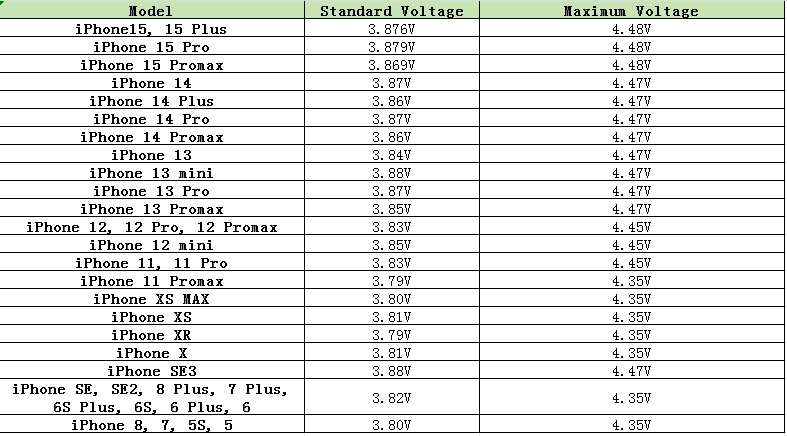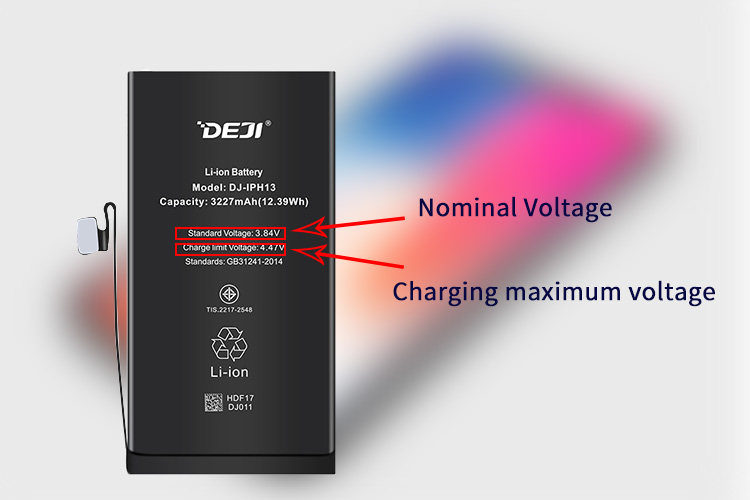Since the launch of the first iPhone over a decade ago, battery capacity has been a key focus for users anticipating each new model. However, what's less known is the impact of iPhone battery voltage on this capacity. This article delves into the concepts of iPhone battery voltage and capacity, providing a deeper insight into iPhone batteries.
What is iPhone Battery Voltage?
- Nominal Voltage: Lithium batteries feature a nominal voltage, which is the average voltage during normal use. For most lithium-ion batteries, this is around 3.8 volts.
- Maximum and Minimum Voltage: Lithium batteries have a maximum safe voltage limit during charging, typically around 4.2 to 4.4 volts. Exceeding this indicates overcharging. During discharge, the voltage should not drop below a certain minimum (usually about 2.5 to 3.0 volts), as falling below this range can lead to over-discharge, a primary cause of battery swelling.
The Evolution of iPhone Battery Voltage
- The original iPhone 4's battery voltage ranged from 3.7V to 4.2V. This increased in subsequent models, with the iPhone 5 to XR series around 3.8-4.35V, and the iPhone 11 to iPhone 13 series slightly higher at 3.83-4.47V. The battery voltage for the iPhone 14 series is 3.84-4.47V, while the battery voltage for the iPhone 15 series is 3.869V-4.48V.

- It's evident that the designed iPhone battery voltage has been modestly rising, corresponding with increasing battery capacity. Higher lithium battery voltage typically indicates greater capacity.

How is iPhone Battery Capacity Determined?
- Measuring Nominal Voltage: The process starts by determining the battery's nominal voltage, its average during normal operations.
- Discharge Test: Under controlled conditions, the battery is discharged from 100% to 0%. The total amount of electricity released is measured.
- Calculating Capacity:
- In milliampere-hours (mAh), this value is determined by measuring the current provided during discharge and combining it with the discharge duration.
- In watt-hours (Wh), it's the energy produced during discharge, calculated by multiplying the average voltage with discharge duration and current.
- Repeated Testing: To ensure accuracy, these tests are often repeated under varying charging cycles and temperature conditions.
Apple lists iPhone battery capacities in its official specifications, reflecting maximum storage capacity under standardized test conditions. However, actual performance can vary due to factors such as temperature, battery aging, and usage patterns.
Design Capacity vs. Actual Capacity
- Design Capacity: This refers to the nominal capacity of a battery as it leaves the factory, measured in mAh or Ah, and is usually noted on the battery label. Each iPhone generation has a different design capacity, with incremental increases each year.
- Actual Capacity: This is the maximum capacity at a given moment. Typically, a new phone's actual capacity is higher than its design capacity, but this decreases with battery cycle count. The main distinction is that design capacity is a fixed value, while actual capacity is dynamic and decreases over time. In essence, actual capacity is the more crucial metric to consider.
Battery Voltage and Usage Time
An interesting fact is that lithium batteries tend to have longer usage times when they're at nominal voltage. Usually, the 20%-80% charge range maintains the battery at nominal voltage, which is why Apple recommends this charging and discharging range.
Calculating iPhone Battery Health Percentage
When checking battery details, battery life is often shown as a percentage. This number represents the battery's wear and is calculated as Battery Life = Actual Capacity / Design Capacity. The resulting percentage is the current battery life.
Conclusion
Understanding the nuances of iPhone battery voltage and capacity offers more than just technical knowledge; it empowers users to make informed decisions about their device usage and maintenance. As we've seen, the evolution of iPhone battery technology, from the iPhone 4 to the latest iPhone 14, demonstrates Apple's commitment to enhancing battery performance while balancing longevity and efficiency.
The relationship between battery voltage and capacity is a critical aspect of this evolution. Higher voltages in newer models correlate with increased capacities, providing users with longer usage times and more reliable performance. However, this also underscores the importance of proper battery care. Adhering to recommended practices, such as maintaining a charge between 20%-80%, can significantly extend your iPhone's battery life and ensure its optimum performance over time.
Do you need help? We are DEJI, a professional mobile phone battery manufacturer. Our latest product, the DJ battery, is made from the highest quality raw materials and can display a 100% health status.
 sales@batterydeji.com
sales@batterydeji.com




